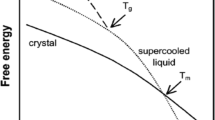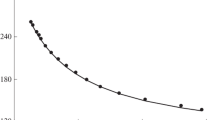Abstract
The glass transition temperature of an amorphous pharmaceutical solid is a critical physical property which can dramatically influence its chemical stability, physical stability, and viscoelastic properties. Water frequently acts as a potent plasticizer for such materials, and since many amorphous solids spontaneously absorb water from their surroundings the relationship between the glass transition temperature and the water content of these materials is important. For a wide range of amorphous and partially amorphous pharmaceutical solids, it was found that there is a rapid initial reduction in the glass transition temperature from the dry state as water is absorbed, followed by a gradual leveling off of the response at higher water contents. This plasticization effect could generally be described using a simplified form of the Gordon–Taylor/ Kelley–Bueche relationships derived from polymer free volume theory. Most of the systems considered showed a nearly ideal volume additivity and negligible tendency to interact. This is consistent with the hypothesis that such mixtures behave as concentrated polymer solutions and indicates that water acts as a plasticizer in a way similar to that of other small molecules and not through any specific or stoichiometric interaction process(es).
Similar content being viewed by others
REFERENCES
L. C. E. Struik. Physical Aging in Amorphous Polymers and Other Materials, Elsevier, New York, 1978.
E. Fukuoka, M. Makita, and S. Yamamura. Glassy state of pharmaceuticals. 3. Thermal properties and stability of glassy pharmaceuticals and their binary glass systems. Chem. Pharm. Bull. 37:1047–1050 (1989).
H. A. Schneider and E. A. Di Marzio. The glass temperature of polymer blends: Comparison of both the free volume and the entropy predictions with data. Polymer 33:3453–3461 (1992).
D. W. Van Krevelen and P. J. Hoftyzer. Properties of Polymers: Their Estimation and Correlation with Chemical Structure, Elsevier, Amsterdam, 1976.
A. Saleki-Gerhardt. Role of Water in the Solid-State Properties of Crystalline and Amorphous Sugars, Ph.D. thesis, University of Wisconsin—Madison, 1993.
F. Franks, R. H. M. Hatley, and S. F. Mathias. Materials science and the production of shelf-stable biologicals. Pharm. Technol. March:32–50 (1992).
Chemical Rubber Company. Handbook of Chemistry and Physics, 73rd ed., CRC Press, Boca Raton, FL, 1993.
P. Molyneux. Water Soluble Synthetic Polymers: Properties and Behaviour, CRC Press, Boca Raton, FL, 1982.
M. Sugisaki, H. Suga, and S. Seki. Calorimetric study of the glassy state. 4. Heat capacities of glassy water and cubic ice. Bull. Chem. Soc. Japan 41:2591–2599 (1968).
J. M. Pochan, C. L. Beatty, and D. F. Pochan. Different approach for the correlation of the T g of mixed amorphous systems. Polymer 30:879–886 (1979).
H. A. Schneider. Glass transition behaviour of compatible polymer blends. Polymer 30:771–779 (1989).
M. Gordon and J. S. Taylor. Ideal co-polymers and the second order transitions of synthetic rubbers. 1. Non-crystalline copolymers. J. Appl. Chem. 2:493–500 (1952).
F. N. Kelley and F. Bueche. Viscosity and glass temperature relations for polymer diluent systems. J. Polym. Sci. 50:549–556 (1961).
R. Simha and R. F. Boyer. General relation involving the glass transition temperature and coefficient of expansion of polymers. J. Chem. Phys. 37:1003 (1962).
T. G. Fox. Second order transition temperatures and related properties of polystyrene. 1. Influence of molecular weight. J. Appl. Phys. 21:581–591 (1950).
P. R. Couchman and F. E. Karasz. A classical thermodynamic discussion of the effect of composition on glass transition temperatures. Macromolecules 11:117–119 (1978).
T. K. Kwei, E. M. Pearce, J. R. Pennacchia, and M. Charton. Correlation between the glass transition temperatures of polymer mixtures and intermolecular force parameters. Macromolecules 20:1174–1176 (1987).
M.-J. Brekner, H. A. Schneider, and H.-J. Cantow. Approach to the composition dependence of the glass transition temperature of compatible polymer blends. 2. The effect of local chain orientation. Makromol. Chem. 189:2085–2097 (1988b).
F. Franks. Water solubility and sensitivity—hydration effects. In C. A. Finch (ed.), Chemistry and Technology of Water Soluble Polymers, Plenum Press, New York, 1981, pp. 157–178.
M. C. Righetti, G. Ajroldi, and G. Pezzin. The glass transition temperature of polymer-diluent systems. Polymer 33:4779–4785 (1992).
J. Verhoeven, R. Schaeffer, J. A. Bouwstra, and H. E. Juninger. The physico-chemical characterization of poly(2-hydroxyethyl methacrylate-co-methacrylic acid). 2. Effect of water, PEG 400 and PEG 6000 on the glass transition temperature. Polymer 30:1946–1950 (1989).
M. Ilvasky, K. Dusek, J. Vacik, and J. Kopecek. Deformation, swelling and potentiometric behaviour of ionised gels of 2-hydroxyethylmethacrylate-methacrylic acid copolymers. J. Appl. Polym. Sci. 23:2073–2082 (1979).
K. J. Zeleznak and R. C. Hoseney. The glass transition in starch. Cereal Chem. 64:121–124 (1987).
H. Levine and L. Slade. Glass transitions in foods. In H. G. Scwartzberg and R. W. Hartel (eds.), Physical Chemistry of Foods, Marcel Dekker, New York, 1992.
H. Batzer and U. T. Kreibich. Influence of water on thermal transitions in natural polymers and synthetic polyamides. Polym. Bull. 5:585–590 (1981).
J. M. G. Cowie. Polymers: Chemistry and Physics of Modern Materials, International Textbook, Aylesbury, UK, 1973.
G. Zografi, M. Kontny, A. Yang, and G. Brenner. Surface area and water vapor sorption of microcrystalline cellulose. Int. J. Pharm. 18:99–116 (1984).
N. L. Salmen and E. L. Back. The influence of water on the glass transition temperature of cellulose. Tappi 60:137–140 (1977).
D. T. Turner and A. Schwartz. The glass transition temperature of poly(N-vinylpyrrolidone) by differential scanning calorimetry. Polymer 26:757–762 (1985).
B. C. Hancock and G. Zografi. The use of solution theories for predicting water vapor absorption by amorphous pharmaceutical solids: A test of the Flory-Huggins and Vrentas models. Pharm. Res. 10:1262–1267 (1993).
Author information
Authors and Affiliations
Rights and permissions
About this article
Cite this article
Hancock, B.C., Zografi, G. The Relationship Between the Glass Transition Temperature and the Water Content of Amorphous Pharmaceutical Solids. Pharm Res 11, 471–477 (1994). https://doi.org/10.1023/A:1018941810744
Issue Date:
DOI: https://doi.org/10.1023/A:1018941810744




